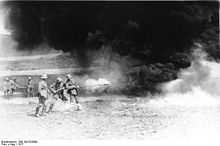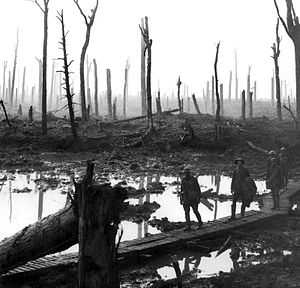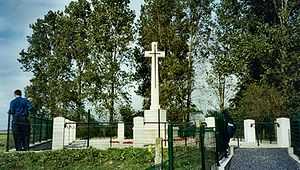Hooge in World War I
In World War I, the small village of Hooge in the Ypres Salient was the site of intense and sustained fighting between German and Allied forces. Hooge is located on the Bellewaerde Ridge, about 4 kilometres east of Ypres in the Flemish province of West-Vlaanderen in Belgium.
World War I
For much of the war, the region around Hooge belonged to one of the eastern-most sectors of the Ypres Salient. From 1914 the front line of the salient ran through the Hooge area and there was almost constant fighting in the region over the next three years, during which the village and the Château de Hooge, a local manor house which served as country house of the local landed gentry and residence of the lord of the manor, were totally destroyed.[1]
Autumn 1914
During the First Battle of Ypres (19 October – 22 November 1914), when the Allies captured the town of Ypres from the Germans, the Château de Hooge was used by the commanders of the 1st and 2nd Divisions for their joint divisional headquarters.[2] When the château was shelled by German forces on 31 October 1914, the commanders of both divisions (Major Generals S.H. Lomax and C.C. Monro) were injured, as were several members of their staffs, and some British soldiers were killed.[3] Lomax died of his wounds several months later. By the end of the battle in November 1914 the Germans had been driven back, but the front line of the Ypres Salient now ran around Hooge.[4]
1915 - 1918


During the Second Battle of Ypres (22 April – 25 May 1915), Hooge was again the site of intense fighting, including the Battle of Bellewaarde which was fought in the area from 24–25 May 1915. Between 24 May and 3 June 1915, German forces began to attack the Château de Hooge, and despite the firing of a large mine by the British on 19 July (see below), the Germans took control of Hooge and the surrounding area on 30 July.[5]
This 30 July 1915 at Hooge also marked the first time when soldiers of the German Army used the flame thrower in a concerted action during battle. At 03.15 a.m. jets of flames from these new devices swept across the British trenches, which were occupied at that time by companies of the 8th Rifle Brigade.[1] In that area of the Western Front, the lines were just 4.5 metres (4.9 yd) apart. The casualties were caused mainly by soldiers being flushed into the open by the fire bursts and being shot by the enemy rather than from the fire bursts itself.[6]
By July 1915 artillery had reduced the Château de Hooge to rubble and it was never rebuilt.[7] The site of the château and the mine crater of 19 July 1915 were retaken by the British 6th Division on 9 August 1915,[3] reclaimed by the Germans on 16 June 1916 and retaken by the British on 31 July 1917 when the 8th Division managed to push past it by about a mile.[5] The Germans retook Hooge in April 1918 as part of the Spring Offensive but were driven back from the area by the British on 28 September[3] as the offensive faltered.
Mining operations
As part of their efforts to gain control of the area, both sides exploded mines beneath the front line trenches at Hooge, the evidence of which are still visible today.[7] On 21 February 1915, the Germans exploded the first mine beneath the trenches at Hooge.[7]
As part of their continued operations against the Salient after the Second Battle of Ypres and the Battle of Bellewaarde, the German forces kept seeking to gain Hooge between 24 May and 3 June 1915.[5] In the grounds of the Château de Hooge was a German strongpoint which was proving particularly troublesome to the British forces defending the area. The redoubt had in fact been started by the British but had fallen into German hands.[4]
In order to break the stalemate, the 175th Tunnelling Company of the Royal Engineers dug a tunnel about 66 yards (60 m) long[4] under the German position and placed a mine there. This occurred during a time of relative quiet on the British part of the Western Front, when few major assaults were made. Nonetheless, the average casualty rate for the British and Commonwealth forces was around 300 per day.[1]
The officer in charge of tunneling and laying the mine at Hooge was Lieutenant Geoffrey Cassels, and the work was completed in five and a half weeks. The first attempt at tunnelling for the mine, starting from within a stable, failed because the soil was too sandy. A second shaft was sunk from the ruins of a gardener's cottage nearby. The main tunnel was in the end 190 feet (58 m) long, with a branch off this after about 70 feet (21 m), this second tunnel running a further 100 feet (30 m) on. The intention was to blow two charges under the German concrete fortifications, although the smaller tunnel was found to be off course. The explosive – used for the first time by the British – was ammonal supported by gunpowder and guncotton, making the Hooge mine the largest mine of the war thus far built.[1] The main difficulties for the tunnellers were that the water table is very high, and that the clay expands as soon as it comes into contact with the air.[4]
At 07.00 p.m. on 19 July 1915 the mine was fired. The explosion created a hole some 6.6 yards (6 m) deep and almost 44 yards (40 m) wide.[4] The far side of the crater was then taken and secured by men from the 1st Battalion, Gordon Highlanders and 4th Battalion, Middlesex Regiment. Ten of the latter were killed by debris from the mine as they waited in advanced positions.[1] The Germans tried to recover their lost position but were driven back by infantry and a heavy artillery bombardment.[4] By 30 July the German units had managed to take control of the château and the surrounding area.[5] Fighting continued until 1918, with the Hooge Crater (craters being strategically important in relatively flat countryside) frequently changing sides.[5]
On 6 June 1916, the Germans detonated four mines beneath the British trenches at Hooge. After intense and sustained fighting, they also retook the crater created by the British mine on 19 July 1915 as well as the British front line.[7]
Cemeteries and memorials


Among those killed in the fighting in Hooge was Gerard Anderson, the British hurdler who participated in the 1912 Stockholm Olympics and died in November 1914.[3][8]
Hooge became the location for a war cemetery (Hooge Crater CWGC) in October 1917. Opposite the cemetery there is now a museum, founded in 1994.[9]
Although the crater created by the British mine on 19 July 1915 was filled in after the war as untenable and repository of hundreds of bodies, several other large mine craters that were created over the course of the fighting[10] can still be seen. The most visible evidence remaining today is a large pond near the hotel and restaurant at the Bellewaerde theme park. The site is the result of Baron de Wynck, who landscaped three mine craters (blown by German units in June 1916 as part of their offensive against Canadian troops) into the existing pond near the hotel (image).
A short distance away is the RE Grave, Railway Wood, which marks the spot where twelve soldiers (eight Royal Engineers of the 177th Tunnelling Company and four attached infantrymen) were killed between November 1915 and August 1917 whilst tunnelling under the hill near Hooge during the defence of Ypres, and their bodies not recovered.[3][11] One of the twelve men commemorated here is Second Lieutenant Charles Geoffrey Boothby (1894–1916), whose wartime letters to his girlfriend were published in 2005.[12]
Notes
- ↑ 1.0 1.1 1.2 1.3 1.4 Hooge on ww1battlefields.co.uk, accessed 25 April 2015
- ↑ Duffy, Michael firstworldwar.com 25 August 2002, accessed 16 February 2007
- ↑ 3.0 3.1 3.2 3.3 3.4 Commonwealth War Graves Commission, undated, accessed 16 February 2007
- ↑ 4.0 4.1 4.2 4.3 4.4 4.5 http://www.webmatters.net/belgium/ww1_hooge.htm access date 24 April 2015
- ↑ 5.0 5.1 5.2 5.3 5.4 Battlefields 14-18, undated, accessed 16 February 2007
- ↑ First World War, Willmott, H.P., Dorling Kindersley, 2003, Page 106
- ↑ 7.0 7.1 7.2 7.3 With the British Army in Flanders: Hooge Crater, access date 26 April 2015.
- ↑ ENGLAND LOSING ATHLETES; Many Prominent in Sporting Circles Die on Battle Fields. New York Times. Dec 1, 1914
- ↑ firstworldwar.com Hooge Museum
- ↑ WWI Battlefields, undated, accessed 16 February 2007
- ↑ wo1.be, accessed 19 June 2006
- ↑ Arthur Stockwin (ed.), Thirty-odd Feet Below Belgium: An Affair of Letters in the Great War 1915-1916, Parapress (2005), ISBN 978-1-89859-480-2 (online)
External links
Coordinates: 50°50′46.97″N 2°56′36.73″E / 50.8463806°N 2.9435361°E